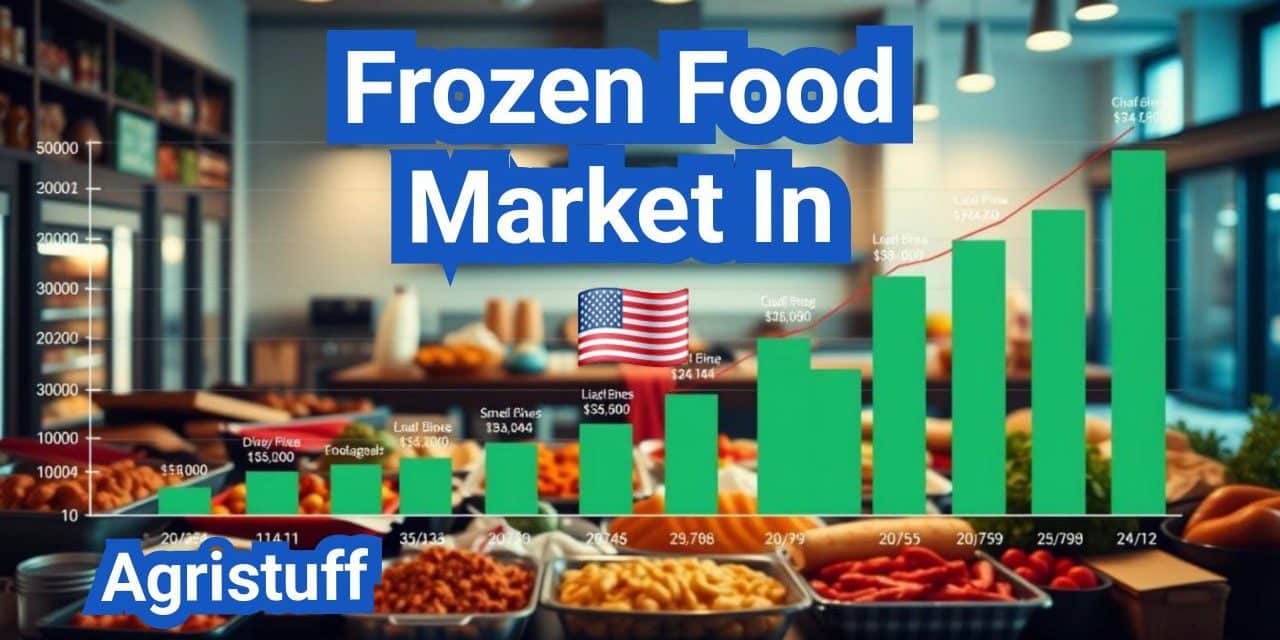The U.S. frozen food market has seen significant growth in recent years, driven by changing consumer preferences and lifestyles. With an estimated size of USD 83.50 billion in 2024, the market is expected to grow at a CAGR of 8.1% from 2025 to 2030.
Consumers are increasingly turning to frozen meals and frozen pizza due to their convenience, health-consciousness, and sustainability. The demand for these products is driven by busy lifestyles and the need for quick, easy, and nutritious meals.
Key Takeaways
- The U.S. frozen food market is expected to grow at a CAGR of 8.1% from 2025 to 2030.
- Consumer demand is driven by convenience, health-consciousness, and sustainability.
- Frozen meals and frozen pizza are popular products in the market.
- The market size was estimated at USD 83.50 billion in 2024.
- Busy lifestyles are driving the demand for quick and easy meals.
The U.S. Frozen Food Market Size and Growth
The frozen food sector in the U.S. is witnessing a notable increase in demand, reflecting broader culinary trends. As consumer habits evolve, the market is adapting, leading to considerable growth.
The frozen food market’s expansion is driven by various factors, including convenience, extended shelf life, and changing consumer preferences. This growth is evident in the current market valuation and statistics.
Current Market Valuation and Statistics
The U.S. frozen food market is expected to reach USD 132.67 billion by 2030, growing at a CAGR of 8.1% from 2025 to 2030. This substantial growth is a testament to the increasing demand for frozen foods across various categories.
| Category | 2025 Valuation (USD Billion) | 2030 Valuation (USD Billion) | CAGR (%) |
|---|---|---|---|
| Frozen Foods | 80.00 | 132.67 | 8.1 |
| Frozen Vegetables | 12.00 | 20.00 | 8.5 |
| Frozen Seafood | 8.00 | 13.00 | 8.0 |
| Frozen Meals | 15.00 | 25.00 | 8.2 |
Year-Over-Year Growth Patterns
Analyzing year-over-year growth patterns provides insights into the market’s dynamics. The U.S. frozen food market has consistently shown positive growth, driven by consumer demand for convenient and nutritious meal options.
The growth is also attributed to the increasing popularity of frozen foods among various consumer segments, including health-conscious individuals and busy households.
How to Navigate Today’s Frozen Food Aisles
With the rise of online grocery shopping, understanding how to navigate frozen food aisles in-store or online has become increasingly important. As consumers, we’re faced with a myriad of choices in the frozen food section, from meal options to vegetables and seafood.
Understanding Department Organization
Most grocery stores organize their frozen food departments into categories such as meals, vegetables, fruits, meats, and desserts. Understanding this organization can help you quickly locate the products you need. For instance, many stores now have a dedicated section for plant-based frozen foods, reflecting the growing demand for such products.
Decoding Package Labels and Claims
Package labels contain a wealth of information, from nutritional content to cooking instructions. Being able to decode these labels can help you make informed purchasing decisions. Look for key claims such as “non-GMO,” “organic,” or “low sodium” that align with your dietary preferences or requirements.
Some packages may also highlight certain nutritional benefits or cooking methods. For example, a frozen meal might be labeled as “high in protein” or “microwaveable in 3 minutes.” Understanding these claims can help you choose products that fit your lifestyle.
Using Store Apps to Locate Products
Many grocery stores now offer apps that can help you navigate their stores, including the frozen food aisles. These apps can be used to create shopping lists, find products in the store, and even check prices. By using these apps, you can streamline your shopping experience and ensure that you don’t miss out on any of the products on your list.
As frozen food sales continue to grow, leveraging these tools and strategies can enhance your shopping experience, whether you’re shopping in-store or online.
Key Factors Driving Consumer Frozen Food Purchases

The demand for frozen foods is on the rise, influenced by convenience, shelf life, and global events like the pandemic. As consumers increasingly turn to frozen food options, understanding the driving factors behind these purchases becomes crucial.
Convenience and Time-Saving Benefits
One of the primary drivers of frozen food sales is the convenience they offer. Busy lifestyles and the need for quick meal solutions have made frozen foods an attractive option. Frozen meals and snacks can be prepared in minutes, saving time for consumers.
A survey of consumer preferences highlights that ease of preparation is a significant factor. Frozen food products that can be cooked directly from the freezer are particularly popular.
| Convenience Factor | Consumer Preference |
|---|---|
| Easy Meal Preparation | High |
| Quick Cooking Time | Very High |
| Minimal Food Waste | Medium |
Extended Shelf Life Advantages
Frozen foods offer an extended shelf life compared to fresh produce, which is a significant advantage for consumers looking to plan meals ahead and reduce food waste. The longer storage capability of frozen foods allows for stockpiling and flexibility in meal planning.
Pandemic-Influenced Buying Patterns
The COVID-19 pandemic has had a profound impact on consumer behavior, with a notable increase in demand for frozen foods. Online frozen food sales saw a 75% increase in 2020, as consumers stockpiled pantry staples and sought convenient meal options during lockdowns.
This shift in buying patterns highlights the adaptability of the frozen food market to global events and consumer needs.
How to Select Quality Frozen Meals
Navigating the frozen meal aisle requires more than just grabbing the cheapest option; it demands a discerning eye for quality. With frozen meals accounting for a significant revenue share in the U.S. frozen food market, consumers are increasingly seeking healthy and nutritious options.
Nutritional Criteria to Consider
When selecting quality frozen meals, nutritional content is paramount. Look for meals that offer a balance of protein, healthy fats, and complex carbohydrates. It’s also crucial to check the sodium content, as many frozen meals can be high in salt. Opt for meals with fewer than 600 milligrams of sodium per serving.
Additionally, consider the ingredient list. Meals with whole, recognizable ingredients are generally preferable to those with a long list of preservatives and additives. Choosing meals with vegetables and lean proteins can enhance nutritional value.
Premium vs. Budget Options: What You Get
The frozen meal market offers a range of options, from budget-friendly to premium. Budget options are often more processed and may contain more sodium and preservatives. In contrast, premium frozen meals typically use higher-quality ingredients and may offer more sophisticated flavor profiles.
While budget options can be convenient and affordable, premium options often justify their higher price with better nutritional profiles and taste. Consumers should weigh their priorities when deciding between budget and premium frozen meals.
Health-Focused Meal Solutions
For consumers prioritizing health, there are numerous health-focused frozen meal solutions available. Many brands now offer organic, gluten-free, and vegan options. These meals are designed to cater to specific dietary needs and preferences.
When opting for health-focused meals, it’s essential to read labels carefully. Look for certifications like USDA Organic or Gluten-Free Certification to ensure the product meets your dietary requirements. Health-focused meals can be a convenient way to maintain a balanced diet.
Exploring the Frozen Pizza Market Segment

The frozen pizza market is a thriving segment of the U.S. frozen food industry, with numerous brands and varieties available. Consumers are drawn to frozen pizzas for their convenience, affordability, and the ability to customize toppings and ingredients.
Best-Selling Brands and Varieties
The frozen pizza market is dominated by several key brands, including Digiorno, Tombstone, and Rosen’s. These brands offer a range of flavors and crust styles, from classic cheese to meat-lovers and gluten-free options.
| Brand | Popular Varieties | Notable Features |
|---|---|---|
| Digiorno | Classic Cheese, Rising Crust | High-quality ingredients, variety of crust options |
| Tombstone | Original, Meat Lover’s | Classic frozen pizza taste, affordable |
| Rosen’s | Cheese, Pepperoni | Simple ingredients, budget-friendly |
Artisanal and Gourmet Pizza Trends
In recent years, there has been a trend towards artisanal and gourmet frozen pizzas. Brands like Cali’Pizza and Udi’s offer high-end ingredients and unique flavor combinations, such as truffle oil and fig sauce.
How to Upgrade Store-Bought Frozen Pizza
To take your frozen pizza to the next level, consider adding fresh toppings such as arugula, prosciutto, or caramelized onions. You can also enhance the flavor by drizzling with olive oil or balsamic glaze.
- Add fresh vegetables for added nutrition and flavor
- Use high-quality meats like prosciutto or sausage
- Experiment with different cheeses, such as mozzarella or parmesan
By following these tips, you can enjoy a delicious and satisfying frozen pizza that rivals delivery from your favorite pizzeria.
Maximizing Nutrition with Frozen Vegetables
Maximizing nutrition starts with the right choices, and frozen vegetables are a great start. Frozen vegetables are picked at peak ripeness and then flash-frozen, preserving their nutritional content. This process allows consumers to enjoy vegetables year-round, regardless of the season.
Comparing Single Vegetables vs. Medleys
When it comes to frozen vegetables, consumers have the option of choosing single vegetables or medleys. Single vegetables, such as peas or broccoli, offer the flexibility to use exactly what a recipe calls for. On the other hand, medleys provide a convenient mix of various vegetables, which can be a time-saver in meal preparation.
Single Vegetables: Allow for precise usage as per recipe requirements.
Medleys: Offer a mix of vegetables, saving time in meal prep.
Value-Added Vegetable Products Worth Trying
Value-added frozen vegetable products have become increasingly popular. These products are not just plain frozen vegetables; they are often seasoned, sautéed, or roasted, making them ready to cook or even ready to eat.
- Roasted vegetable blends
- Sautéed spinach with garlic
- Steamed vegetable medleys with herbs
Organic and Clean Label Options
For consumers who prioritize organic or clean label products, many frozen vegetable options are available. Organic frozen vegetables are grown without synthetic pesticides or fertilizers, while clean label products have fewer, more natural ingredients.
Look for certifications like USDA Organic to ensure you’re getting a product that meets your standards.
How to Choose High-Quality Frozen Seafood

With the increasing demand for seafood, understanding how to choose high-quality frozen options is crucial for both taste and nutritional value. Consumers are increasingly seeking sustainable and responsibly sourced seafood options, with certifications like MSC and ASC gaining prominence.
Evaluating Sustainable Seafood Certifications
When selecting frozen seafood, one of the key factors to consider is sustainability. Certifications such as the Marine Stewardship Council (MSC) and Aquaculture Stewardship Council (ASC) ensure that the seafood is sourced responsibly. These certifications guarantee that the seafood is caught or farmed in ways that minimize environmental impact and respect social standards.
Key certifications to look for include:
- MSC (Marine Stewardship Council): For wild-caught seafood, ensuring it’s from a well-managed fishery.
- ASC (Aquaculture Stewardship Council): For farmed seafood, promoting responsible aquaculture practices.
- Best Aquaculture Practices (BAP): Covers all aspects of aquaculture, including environmental and social responsibility.
Popular Fish and Shellfish Product Types
Frozen seafood encompasses a wide variety of fish and shellfish products, catering to diverse consumer preferences. Popular categories include:
- Wild-caught fish such as salmon, cod, and tilapia.
- Shellfish like shrimp, scallops, and mussels.
- Value-added products such as fish sticks and breaded shrimp.
Understanding these categories can help consumers make informed choices based on their dietary needs and preferences.
Value-Added and Ready-to-Cook Seafood Options
Value-added frozen seafood products offer convenience without compromising on quality. These products are often pre-seasoned, pre-cut, or pre-cooked, making meal preparation easier and faster. Examples include:
- Ready-to-cook fish fillets with marinades.
- Pre-cooked shrimp or crab legs for direct consumption or easy incorporation into meals.
- Seafood mixes that combine various types of fish and shellfish for a convenient meal solution.
These options not only save time but also reduce food waste by providing the exact quantity needed for a meal.
Quick Breakfast Solutions in the Freezer Aisle

In the quest for quicker mornings, frozen breakfast solutions have emerged as a savior for many busy households. The frozen breakfast aisle is stocked with a variety of products designed to cater to different tastes and dietary needs.
Comparing Breakfast Sandwiches and Burritos
Breakfast sandwiches and burritos are two of the most popular frozen breakfast items. While both offer convenience, they differ significantly in terms of ingredients and nutritional content. Breakfast sandwiches typically consist of an egg, cheese, and meat on a bread roll, whereas burritos wrap these ingredients along with beans, vegetables, and sometimes salsa, in a tortilla.
When choosing between the two, consider the nutritional value. Breakfast sandwiches can range from 300 to over 500 calories, depending on the meat and cheese used. Burritos, on the other hand, can be more calorie-dense due to the additional fillings, potentially exceeding 600 calories.
Key Comparison Points:
- Calorie count
- Protein content
- Presence of whole grains
- Vegetable content
| Product | Calories | Protein (g) | Whole Grains |
|---|---|---|---|
| Breakfast Sandwich | 350 | 20 | Yes |
| Breakfast Burrito | 550 | 30 | Yes |
Waffles, Pancakes, and French Toast Options
Frozen waffles, pancakes, and French toast offer a sweet start to the day. These products are often made with a variety of ingredients, including whole grains and fruit. When selecting, look for options that are low in added sugars and made with wholesome ingredients.
Some brands now offer organic and non-GMO versions of these breakfast treats, catering to consumers with specific dietary preferences. The cooking method can also impact the nutritional value; for instance, baking instead of frying can significantly reduce fat content.
Nutritional Considerations for Frozen Breakfast Items
When incorporating frozen breakfast items into your diet, several nutritional factors should be considered. First, check the ingredient list for whole grains, lean proteins, and a balance of vegetables. Be mindful of sodium content, as many frozen breakfast items can be high in salt.
Additionally, consider the presence of additives and preservatives. Some products may contain artificial flavors or colors, which may be a concern for consumers with sensitivities or preferences for natural foods.
Nutritional Tips:
- Opt for products with fewer ingredients
- Choose items with balanced macronutrients
- Be aware of portion sizes
Navigating the Plant-Based Frozen Foods Segment

The plant-based frozen foods market is evolving, driven by consumer interest in sustainable eating and healthy living. This segment has seen significant growth as more consumers adopt plant-based diets, seeking out frozen food options that align with their dietary preferences.
Evaluating Meat Alternatives
Meat alternatives are a crucial component of the plant-based frozen foods segment. Consumers are looking for products that not only taste good but also provide a similar texture to meat. Plant-based meat alternatives made from pea protein, soy, or mushroom-based ingredients are gaining popularity. When evaluating these products, consider factors such as ingredient list, nutritional content, and certifications like Non-GMO or Certified Plant-Based.
- Look for products with minimal processing and fewer ingredients.
- Check the nutritional label for protein content, sodium levels, and presence of additives.
- Consider the environmental impact of the packaging.
Complete Plant-Based Frozen Meals
Complete plant-based frozen meals offer convenience without compromising on dietary preferences. These meals range from vegan stir-fries to plant-based pasta dishes. When selecting complete meals, consider the balance of nutrients, including protein, healthy fats, and complex carbohydrates. Look for meals that are rich in fiber and low in sodium. Additionally, opting for meals with organic or non-GMO ingredients can be beneficial for those who prioritize these aspects.
| Meal Type | Nutritional Highlights | Key Ingredients |
|---|---|---|
| Vegan Stir-Fry | High in fiber, low in sodium | Vegetables, tofu, brown rice |
| Plant-Based Pasta | Good source of protein, rich in vitamins | Pasta, marinara sauce, plant-based protein |
Dairy-Free Frozen Options
Dairy-free frozen options cater to consumers who are lactose intolerant or prefer a dairy-free diet. These products include dairy-free ice creams and frozen desserts made from almond milk, coconut milk, or cashew cream. When choosing dairy-free frozen options, consider the ingredient list and nutritional content. Opt for products with natural sweeteners and minimal additives. Additionally, some brands offer fortified dairy-free products with calcium and vitamins, which can be a nutritious choice.
By understanding the various aspects of the plant-based frozen foods segment, consumers can make informed choices that align with their dietary preferences and nutritional needs.
How to Choose Frozen Desserts for Every Occasion

The world of frozen desserts is vast and varied, catering to different tastes and occasions. Whether you’re looking to indulge in a premium treat or seeking a healthier alternative, the frozen dessert aisle has something for everyone.
Premium vs. Regular Ice Cream and Novelties
When it comes to ice cream and novelties, the choice between premium and regular products often comes down to taste preferences and budget. Premium ice creams are typically made with higher-quality ingredients and have a richer, creamier texture. As Haagen-Dazs claims, “Our ice cream is made with the finest ingredients, resulting in a more indulgent experience.”
On the other hand, regular ice creams and novelties can be just as satisfying and are often more budget-friendly. Brands like Blue Bell offer a range of flavors at an affordable price. When choosing between premium and regular, consider the occasion and your budget.
Frozen Cakes and Pastries Worth Trying
Frozen cakes and pastries have come a long way in terms of quality and variety. From Sara Lee cheesecakes to gourmet frozen tiramisu, there’s a wide range of options to satisfy any dessert craving. When selecting frozen cakes and pastries, look for products with high-quality ingredients and minimal preservatives.
“The art of making desserts is not just about taste, but also about presentation and the experience it offers.” –
A renowned pastry chef
Healthier Dessert Alternatives
For those looking for healthier dessert options, the frozen dessert aisle has seen significant innovation. Brands now offer a range of low-calorie, low-sugar, and dairy-free frozen desserts. When opting for healthier alternatives, check the nutrition label to ensure it meets your dietary requirements.
- Look for desserts made with natural sweeteners.
- Choose products with minimal added sugars.
- Consider dairy-free or vegan options for a different nutritional profile.
By considering these factors, you can enjoy frozen desserts that not only taste great but also align with your health goals.
Private Label Frozen Foods: When to Choose Store Brands

In the frozen food aisle, store brands are making a significant impact by offering products that are both affordable and of high quality. As consumers increasingly look for value in their grocery shopping, private label frozen foods have emerged as a viable option.
Quality Comparison with National Brands
Private label frozen foods have made significant strides in terms of quality, often rivaling that of national brands. Many store brands are now produced by the same manufacturers as their national brand counterparts, using similar recipes and production processes.
- Similar Ingredients: Store brands often use similar ingredients to national brands, ensuring comparable taste and nutritional value.
- Comparable Quality Control: Private label products undergo rigorous quality control measures, sometimes even stricter than those of national brands.
- Innovative Products: Store brands are increasingly introducing innovative products that cater to changing consumer preferences, such as organic and gluten-free options.
Price Advantages During Inflation Periods
One of the most significant advantages of private label frozen foods is their price. During periods of inflation, store brands offer a more affordable alternative to national brands, helping consumers save on their grocery bills.
The price difference can be substantial, with private label products often costing 20-30% less than national brands. This makes them an attractive option for budget-conscious shoppers.
Key Benefits:
- Cost Savings: Significant savings on grocery bills, especially during inflation.
- Value for Money: Private label frozen foods offer comparable quality at a lower price.
- Increased Affordability: Makes high-quality frozen foods accessible to a wider range of consumers.
Shopping Strategies During U.S. Food Inflation

With food prices on the rise, shoppers are turning to innovative strategies to stretch their dollars, particularly in the frozen food aisle. As consumers increasingly seek affordable options, frozen foods offer a cost-effective alternative to fresh products.
Price Comparison: Frozen vs. Fresh
One effective shopping strategy is comparing prices between frozen and fresh products. Frozen foods often provide significant savings without compromising on nutritional value. For instance, frozen vegetables are typically just as nutritious as their fresh counterparts, yet they can be more budget-friendly, especially during off-seasons when fresh produce is more expensive.
| Product | Average Price (Fresh) | Average Price (Frozen) |
|---|---|---|
| Broccoli (1 lb) | $2.50 | $1.80 |
| Peas (1 lb) | $3.00 | $2.20 |
| Chicken Breasts (1 lb) | $4.50 | $3.50 |
Bulk Buying and Sale Timing Strategies
Bulk buying and timing purchases during sales can significantly reduce grocery bills. Frozen foods are particularly well-suited for bulk purchases since they have a longer shelf life. By stocking up during sales, consumers can save money and ensure a steady supply of their favorite products.
- Monitor weekly grocery ads for sales on frozen foods.
- Stock up on non-perishable frozen items during promotions.
- Consider purchasing frozen foods in bulk and portioning them out for future meals.
Digital Coupons and Loyalty Programs for Frozen Foods
Many retailers offer digital coupons and loyalty programs that can be used to save on frozen foods. By taking advantage of these programs, shoppers can further reduce their grocery expenses. Some stores also offer exclusive discounts to loyalty program members, making it worthwhile to sign up.
“By combining digital coupons with sale prices, consumers can maximize their savings on frozen foods, making it easier to stick to a budget during times of food inflation.”
In conclusion, by employing these shopping strategies, consumers can effectively manage their grocery expenses during periods of food inflation. Whether it’s comparing prices, buying in bulk, or utilizing digital coupons, there are numerous ways to save on frozen foods.
How to Buy Frozen Foods Through Online Grocery Channels

As online grocery sales continue to grow, consumers are looking for ways to safely and efficiently purchase frozen foods online. The convenience of online shopping is particularly appealing for frozen foods, as it eliminates the need to visit physical stores and potentially exposes consumers to fewer crowds.
Ensuring Proper Delivery Temperature
One of the critical challenges of buying frozen foods online is ensuring that they are delivered at the proper temperature to maintain their quality and safety. Many online grocery retailers now use specialized packaging and insulated bags to keep frozen foods cold during transit. Some companies even use dry ice to maintain the frozen state of products.
When shopping for frozen foods online, it’s essential to:
- Check if the retailer has a good track record of delivering frozen foods at the right temperature.
- Look for options that allow you to track your delivery in real-time.
- Consider choosing delivery windows when you’re available to receive your groceries immediately.
Comparing Direct-to-Consumer Frozen Food Companies
Direct-to-consumer frozen food companies have gained popularity, offering a wide range of products directly to consumers’ doorsteps. When comparing these companies, consider factors such as:
- Product Variety: Look for companies that offer a diverse range of frozen foods, including organic and specialty options.
- Quality Control: Check if the company has robust quality control measures in place, including proper handling and storage procedures.
- Customer Reviews: Read reviews from other customers to understand their experiences with delivery, product quality, and customer service.
Evaluating Subscription Models for Frozen Foods
Subscription models for frozen foods offer convenience and potentially cost savings for regular consumers. When evaluating these models, consider:
- Flexibility: Can you pause or cancel your subscription easily?
- Customization: Can you choose the specific products you receive, or are they pre-selected?
- Discounts: Are there discounts for long-term commitments or referrals?
By carefully considering these factors, consumers can enjoy the convenience of buying frozen foods online while ensuring the quality and safety of their purchases.
Air Fryer-Friendly Frozen Foods: What Works Best
The rise of air fryers has revolutionized the way we cook frozen foods, offering a crispy texture without the need for deep-frying. As a result, consumers are seeking out frozen foods that can be cooked to perfection using these appliances.
Products Specifically Designed for Air Fryers
Several frozen food manufacturers have started developing products specifically designed for air fryers. These products are formulated to cook evenly and achieve the desired crispiness when cooked in an air fryer.
- Frozen French fries with optimized cooking times
- Specially coated chicken nuggets for air fryer use
- Vegetable medleys designed for air fryer cooking
When shopping for air fryer-friendly frozen foods, look for products with labels indicating they are suitable for air fryer cooking.
Converting Traditional Frozen Food Cooking Instructions
For frozen foods not specifically designed for air fryers, consumers can still achieve great results by adjusting the cooking instructions. Here are some tips:
| Traditional Cooking Method | Air Fryer Conversion Tip |
|---|---|
| Baked Goods (e.g., frozen pizzas) | Reduce temperature by 25°F, cook for 75% of recommended time |
| Deep-Fried Foods (e.g., frozen fries) | Use minimal oil, cook at recommended temperature for 50-60% of original time |
| Grilled or Roasted Foods | Adjust temperature as needed, check for doneness at 75% of recommended cooking time |
By following these guidelines, consumers can enjoy a wide range of frozen foods cooked to perfection in their air fryers.
Proper Freezer Storage and Food Safety Guidelines
To keep your frozen foods safe and fresh, it’s essential to follow proper freezer storage guidelines. Maintaining the right temperature and handling practices are crucial for preserving the quality and safety of your frozen foods.
Optimal Storage Times by Food Category
Different types of frozen foods have varying storage times. Here are some general guidelines:
- Frozen meats: 8-12 months
- Frozen vegetables: 8-12 months
- Frozen fruits: 12-18 months
- Frozen prepared meals: 3-6 months
It’s essential to check the specific storage times for each product, as they may vary.
Preventing Freezer Burn and Quality Loss
Freezer burn occurs when frozen foods are exposed to air, leading to dehydration and oxidation. To prevent this:
- Use airtight containers or freezer bags.
- Remove as much air as possible before sealing.
- Label and date containers.
- Store foods at 0°F (-18°C) or below.
Safe Thawing Practices by Food Type
Thawing frozen foods safely is critical to prevent bacterial growth. Here are some safe thawing practices:
- Refrigerator thawing: Thaw foods in the refrigerator, keeping them at 40°F (4°C) or below.
- Cold water thawing: Submerge foods in cold water, changing the water every 30 minutes.
- Microwave thawing: Use the defrost setting, and cook immediately after thawing.
Never thaw foods at room temperature or in hot water.
By following these guidelines, you can ensure the quality and safety of your frozen foods. Proper freezer storage and handling practices are key to enjoying healthy and delicious meals.
Future Trends in the U.S. Frozen Food Market
The U.S. frozen food market is poised for continued growth, driven by consumer demand for convenience, health, and sustainability. As consumers increasingly seek out products that align with these values, manufacturers are responding with innovative offerings that cater to diverse tastes and dietary needs.
Future trends in the U.S. frozen food market will likely be shaped by the ongoing shift towards healthier and more sustainable eating. Plant-based options, organic products, and clean-label ingredients are expected to remain in high demand. Additionally, advancements in packaging and freezing technologies will continue to improve the quality and nutritional value of frozen foods.
As the market continues to evolve, consumers can expect to see more premium and gourmet frozen food options, as well as increased availability of products that cater to specific dietary needs and preferences. The U.S. frozen food market is expected to experience steady market growth, driven by these trends and consumer preferences.
FAQ
What is the current size of the U.S. frozen food market?
The U.S. frozen food market is a significant segment of the overall food industry, with a substantial market size that continues to grow annually.
What factors are driving consumer demand for frozen foods?
Convenience, health-consciousness, and sustainability are key factors driving consumer demand for frozen foods, as consumers seek quick, nutritious, and environmentally friendly meal solutions.
How can I navigate the frozen food aisle effectively?
To navigate the frozen food aisle, understand department organization, decode package labels, and use store apps to locate products, making it easier to find the products you need.
What are the benefits of choosing frozen meals?
Frozen meals offer convenience, extended shelf life, and a range of nutritional options, making them a practical choice for busy consumers seeking quick meal solutions.
How do I select quality frozen meals?
When selecting frozen meals, consider nutritional criteria, premium vs. budget options, and health-focused meal solutions to ensure you’re getting a high-quality product that meets your dietary needs.
What are the trends in the frozen pizza market?
The frozen pizza market is seeing trends in best-selling brands, artisanal and gourmet pizza options, and tips for upgrading store-bought frozen pizza, offering consumers a range of choices.
Are frozen vegetables a nutritious option?
Yes, frozen vegetables are a nutritious option, offering comparisons between single vegetables and medleys, value-added products, and organic choices, making them a great addition to a healthy diet.
How do I choose high-quality frozen seafood?
To choose high-quality frozen seafood, evaluate sustainable seafood certifications, consider popular fish and shellfish product types, and look for value-added and ready-to-cook seafood options.
What are the benefits of plant-based frozen foods?
Plant-based frozen foods offer evaluating meat alternatives, complete plant-based frozen meals, and dairy-free frozen options, catering to the growing demand for plant-based diets.
How can I shop smart during U.S. food inflation?
To shop smart during U.S. food inflation, compare prices between frozen and fresh products, consider bulk buying and sale timing strategies, and utilize digital coupons and loyalty programs for frozen foods.
Can I buy frozen foods online?
Yes, you can buy frozen foods online through various grocery channels, ensuring proper delivery temperature, comparing direct-to-consumer companies, and evaluating subscription models for frozen foods.
What are air fryer-friendly frozen foods?
Air fryer-friendly frozen foods include products specifically designed for air fryers and tips for converting traditional cooking instructions, making it easy to enjoy your favorite frozen foods in a healthier way.
How do I store frozen foods safely?
To store frozen foods safely, follow proper freezer storage guidelines, including optimal storage times by food category, preventing freezer burn, and safe thawing practices by food type.
Conclusion of: Frozen Food Market in the U.S.
Overview: Why the frozen food market keeps winning in the U.S.
The frozen food market in the U.S. has evolved from a pandemic-era spike to a more durable, baseline growth story. Industry trackers estimate retail frozen sales around the mid-$70 billions annually, reflecting how Americans increasingly rely on freezer aisles for dependable value, variety, and speed. This overview sets the stage for what’s selling now and the underlying reasons shoppers continue to build routines around the frozen food market. Frozen food sales near $74.2B (SupplySide FBJ)
Market size and momentum: A resilient frozen food market
Even as eating patterns normalize, the frozen food market remains resilient because it solves everyday problems—budget management, meal planning, and time pressure. Retailers report steady trips and larger baskets when frozen is in the cart, while brands continue to expand assortments into new dayparts and cuisines. These points collectively indicate structural strength for the frozen food market rather than a temporary surge. AFFI Retail & “Power of Frozen” research
Household penetration: Frozen is built into weekly habits
Penetration is high across demographics in the frozen food market, with many households keeping go-to items (vegetables, pizza, entrées, nuggets, seafood) on hand. Shoppers cite weeknight convenience and consistent taste as reasons frozen “earns the right” to be on the weekly list. This everyday reliance is a key moat for the frozen food market. AFFI: Frozen shopper insights
Category leaders: Meals, pizza, sides and desserts anchor the frozen food market
Within the frozen food market, the largest dollar contributors include multi-serve and single-serve meals, pizza, potatoes, vegetables, and indulgent desserts. These segments benefit from clear value propositions—time savings, portion control, and reliable quality. Understanding which segments anchor the basket helps producers and retailers prioritize shelf space in the frozen food market. Category highlights (SupplySide FBJ)
Breakfast boom: Morning occasions expand the frozen food market
Breakfast is one of the fastest-moving occasions in the frozen food market. Consumers are picking heat-and-eat sandwiches, burritos, waffles, protein bowls, and handhelds that deliver taste with speed. Manufacturer trendbooks point to strong morning-daypart innovation, which continues to grow the frozen food market beyond traditional dinner usage. Conagra “Future of Frozen” (2024)
Air fryers and snacking: Appliances supercharge the frozen food market
Air fryer adoption has changed how many people cook, creating crispier results for fries, snacks, breaded chicken, and seafood—an important tailwind for the frozen food market. Coverage citing Circana data shows air fryers in a majority of U.S. homes, unlocking new, repeatable snack and side occasions that keep volume flowing through the frozen food market. Food Dive on air fryer adoption (Circana)
Vegetables and fruit: Core pillars of the frozen food market
Frozen produce remains a staple of the frozen food market because it offers year-round availability, minimal prep, and lower waste. For families on budgets, frozen peas, berries, and blends reduce spoilage and simplify portioning. This reliability entrenches fruits and vegetables as foundational categories within the frozen food market. AFFI: Frozen produce insights
Proteins: Seafood, poultry, and plant-forward options grow the frozen food market
Protein variety is expanding in the frozen food market: shrimp, salmon, chicken strips, meatballs, and plant-forward bowls are all prominent. Consumers want convenient, high-quality proteins that store well and cook quickly. Conference coverage suggests at-home meals remain elevated versus pre-pandemic, which supports protein innovation in the frozen food market. Food Institute: Frozen IQ takeaways
Private label momentum: Value reshapes the frozen food market
Private label has gained share in many center-store categories, and the frozen food market is no exception. As prices rose, shoppers tested store brands and found quality improving, leading to stickier behavior. Elevated private-label penetration increases competitive intensity across the frozen food market. PLMA/Circana: Record store-brand shares
Retail channels: Supermarkets lead, but mass and club shape the frozen food market
Supermarkets remain central to the frozen food market, yet mass merchants and club stores continue to win share with price leadership and bulk formats. This channel mix affects pack sizes, merchandising tactics, and promo cadences needed to succeed in the frozen food market. Grocery Dive: Channel share dynamics
E-commerce: Pickup & delivery expand access to the frozen food market
Online grocery has become a durable habit, benefiting the frozen food market because frozen items ship and substitute more cleanly than fresh. Monthly reads show U.S. eGrocery sales trending high, supporting broader household access to the frozen food market through pickup and delivery. Brick Meets Click: U.S. eGrocery update (June 2025)
Pricing & promotion: Value engineering in the frozen food market
After inflationary years, shoppers in the frozen food market are more surgical—trading sizes, comparing brands, and timing buys with promotions. Federal CPI tables show continued, category-specific price movements that emphasize the need for targeted value messaging across the frozen food market. BLS CPI detailed table
Why consumers buy: Taste, cost, health and convenience in the frozen food market
National surveys consistently show taste and price are top purchase drivers, which aligns with the frozen food market. Convenience and perceived healthfulness also matter—especially when frozen helps with portion control and meal planning. These motivators explain stable repeat rates throughout the frozen food market. Pew Research: What matters in food choices
Protein preference: A durable macro-trend for the frozen food market
Heightened interest in protein continues to guide innovation in the frozen food market. Bowls, entrées, and snacks that foreground grams of protein, along with clear nutrition callouts, can earn premium placement and repeat purchases. Survey data suggests this preference is durable, supporting long-run category health in the frozen food market. IFIC Spotlight Survey on Protein (2025)
Global flavors and plant-forward choices energize the frozen food market
Discovery is another engine for the frozen food market. Globally inspired flavors, spicy profiles, premium sauces, and plant-forward recipes help frozen compete with restaurants while staying weeknight-friendly. Trend roundups that blend manufacturer and syndicated data show these fronts continuing to expand the frozen food market. Future of Frozen trend highlights
Packaging and directions: Reducing friction in the frozen food market
Brands now include air-fryer instructions, resealable closures, and single-serve packs to smooth the path from freezer to table, lifting satisfaction and repeat in the frozen food market. As more households use quick-cook appliances, these details are small but significant levers in the frozen food market. Air-fryer usage & product design (Food Dive)
Merchandising & messaging: Win value first, then trade up in the frozen food market
Leading retailers in the frozen food market tend to pair sharp pricing and clear navigation (value tiers, family size) with discovery endcaps that feature chef-inspired or better-for-you items. This “meet value, then trade up” pattern helps maintain traffic while showcasing innovation across the frozen food market. Frozen IQ: Retailer & brand playbooks
Food safety & storage: Trust underpins the frozen food market
Trust is essential in the frozen food market. Federal guidance emphasizes freezing at 0°F (-18°C) and safe thawing to maintain quality and safety. Educating consumers on storage, refreezing, and reheating safeguards experience—and ultimately, loyalty—in the frozen food market. USDA FSIS: Freezing & Food Safety
Digital acceleration: Why online baskets favor the frozen food market
Durability, pack consistency, and UPC clarity help the frozen food market perform well in e-commerce. Substitution rules are cleaner and fulfillment is more predictable, which reduces friction in pickup and delivery. As eGrocery scales, expect the frozen food market to keep climbing in digital baskets. Brick Meets Click: eGrocery trendline
Outlook: What will shape the next phase of the frozen food market
Winners in the frozen food market will balance value with discovery: bold global flavors, high-protein formats, breakfast and snack solutions, and appliance-friendly cooking. With households mixing thrift and premiumization, focused R&D and smart merchandising can extend the frozen food market runway through the next retail cycle. AFFI: Ongoing category insights
Final thought
The U.S. frozen food market has matured into a dependable growth engine. By aligning price points, elevating flavor, and simplifying the path to a great result at home, brands and retailers can keep frozen top-of-mind—and top-of-basket—across channels in the frozen food market. More on frozen’s outlook (Food Institute)
Sources & References
- SupplySide Food & Beverage Journal: Frozen food sales hit ~$74.2B
- American Frozen Food Institute (AFFI): Retail insights & “Power of Frozen”
- Conagra: Future of Frozen 2024 (trendbook summary)
- Food Dive: Air fryer adoption and frozen (citing Circana)
- PLMA/Circana: Record private-label shares
- Brick Meets Click: U.S. eGrocery sales (June 2025)
- U.S. Bureau of Labor Statistics: CPI Table 2 (Detailed food categories)
- Pew Research Center (May 7, 2025): Americans on healthy food and eating
- IFIC (July 2025): Protein Perceptions Spotlight Survey (PDF)
- The Food Institute: Frozen IQ 2024 coverage
- USDA FSIS: Freezing & Food Safety










